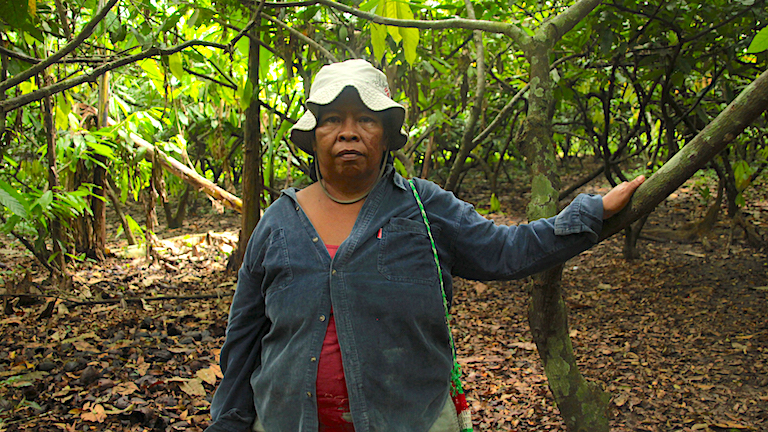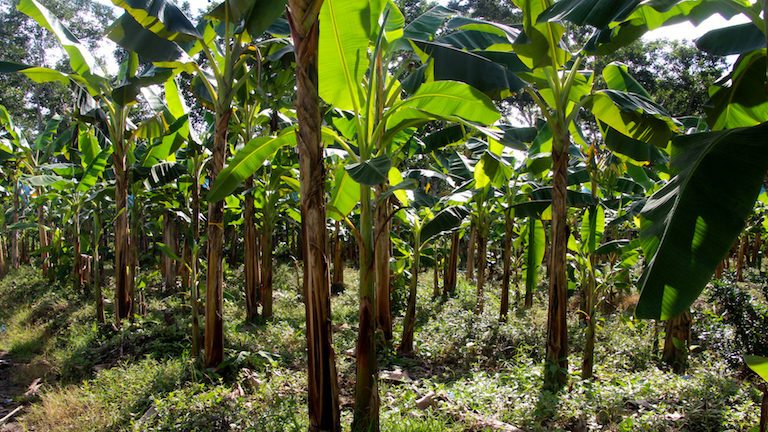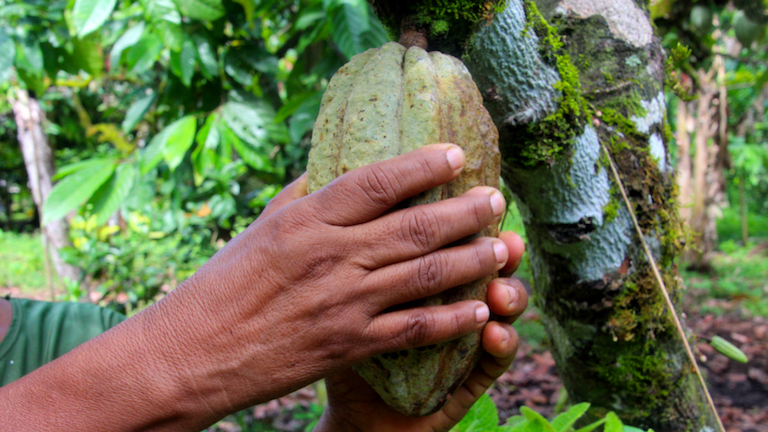- In Costa Rica’s Talamanca region, Indigenous Bribri women are championing sustainable agroforestry practices in a tradition that stretches back for millennia.
- Known as fincas integrales, it’s a system that mimics the diversity and productivity of the forest: timber trees provide shade for fruit trees, which in turn shelter medicinal plants, amid all of which livestock and even wildlife thrive.
- One of the few matrilineal societies in the world, the Bribri women are taking back their leadership after decades of decline and social problems in the community.
- Talamanca is also home to vast monoculture plantations of crops like bananas, a completely different farming system that relies on the heavy use of pesticides — a practice that the Bribri women say destroys the land.
TALAMANCA, Costa Rica — “How do I say lemon in Bribri language?” ask Andy, 9, and his cousin Sergio, 11, of their grandmother, Marina López. They’re playing among cocoa trees in their grandmother’s field in Watsi, a village in southern Costa Rica’s Caribbean region, where their Indigenous Bribri community maintains its ancestral traditions. “Àsh means lemon in Bribri,” Marina tells her grandsons, “Don’t confuse it with another citrus such as àsh blòblo [orange].”
Unexpectedly, rain starts to fall and makes the tropical vegetation shine. The trio find shelter under a roof close to palms and timber-yielding trees that give shade to cocoa and medicinal plants. The community here practices a resilient and ancient agricultural system called agroforestry that also benefits biodiversity and climate change, since perennial and annual crops are grown together to mimic a forest.
López, 57, is one of the leaders of the Bribri people who live in the Talamanca region known for its nature parks, tropical beaches, and mountains stretching to the Sixaola River, which marks the border with Panamá.

The Bribri are one of the world’s few matrilineal societies: land is handed down from mother to daughter. Cocoa is at the center of another noteworthy ancestral practice, forming the core of their sacred rituals. “Cocoa represents women in our cosmovision,” López says. “We drink it for marriages when a person dies, when we are pregnant for the first time. Cocoa is purification, it represents our blood.”

Cocoa: Power, memory, and resistance
Today, López is bringing Sergio and Andy to the field, as her grandmother Adela used to do with her. After the rainfall, she starts pruning the cocoa trees in a way that filters kaleidoscopic light onto the ground. Everything must be done respecting Iriria, as they call mother nature.
In Costa Rica, agroforestry systems are known as fincas integrales, a seemingly disorderly system that reminds one of the creative mess of a tropical forest. Timber trees such as laurel (Cordia alliodora), cedar (Cedrela odorata) and mountain almond (Dipteryx panamensis) dominate these agricultural landscapes. Under their shade grow fruit trees such as orange (Citrus sinensis), lemon (Citrus limonia), star fruit (Averrhoa carambola), soursop (Annona muricata) and sapote (Pouteria sapota). These in turn give needed shade to medicinal plants such as comfrey (Symphytum officinale), goosefoot (Chenopodium graveolens) and hombre grande (Quassia amara), used to heal respiratory diseases and snake bites, among other uses.
These plantings make the community nearly self-sufficient, as they provide food, construction materials, and medicines. “In Bribri territory of Talamanca we found a complex multi-strata system with more than 30 tree species,” says Ricardo Salazar, agroforestry professor and researcher at the Costa Rica Institute of Technology. “Each tree offers different services: timber to build houses and boats, firewood, fruit for food, and crops such as cocoa and banana that could provide extra income to the families.”
The community’s agroforestry plots are also home to a variety of animals, from domestic pigs, chickens and horses, to wildlife such as the yigüirro (also known as the clay-colored thrush, Turdus grayi, the national bird of Costa Rica), toucans (family Ramphastidae), red-lored parrot (Amazona autumnalis), stingless bees (Melipona spp.), important cocoa-pollinating insects such as midges (Forcipomyia spp.), and mammals like the tepezcuintle (or lowland paca, Cuniculus paca) and white-lipped peccary (Tayassu pecari).

Agroforestry: Part of Bribri identity
For Marina López, collecting cocoa with her grandmother is one of her precious childhood memories. Here in the lands where her ancestors founded the community of Watsi, she lives in a wooden house with her father, Samuel, near her daughters and 13 nieces and nephews.
Today, she’s cooking their typical meal, guacho: rice boiled with coriander, meat, chili, basil and onion, accompanied with yucca and a lemon fruit shake (fresco). While she blends the guacho, Marina speaks with her father in the Bribri language, sharing anecdotes of his travels in Guatemala and Nicaragua for 17 years when he was young, before he returned to his cocoa-centric community.
Bribri women like López are the dominant cocoa producers in the region. “Eighty percent of the cocoa producers in Talamanca are women [and] owners of their lands,” says Tania Rodríguez Echavarría, a political ecology professor at the University of Costa Rica (UCR). “This is a relevant issue because in a matrilineal society, lands are owned by women that hand down Bribri culture and language. Being the owner of the lands gives them tools to organize themselves and be the protagonists. I would say that they have a central role in the territory.”
Bribri culture is transmitted through familial clans. There are 13 in the Talamanca region, each one consecrated to a specific animal. This one is part of the Dokuwak, dedicated to the mountain dove, López says.
“My grandmother Adela was the first leader of the Watsi community,” she says. “At the beginning of the 1990s, after the Limon earthquake, we realized that we had lost the leadership in the communities: less participation and only men heading political organizations. For that reason, we decided to create a space to give voice to the women.”
So she and 36 other Bribri leaders started the Association of Indigenous Women of Talamanca (ACOMUITA) to raise the voices and power of women through the social and cultural values of organic cocoa.

Getting to ACOMUITA’s headquarters in Shiroles from Watsi is a rough ride: a few kilometers through luxuriant tropical vegetation, past some local groceries and quiet rivers. Once there, its entrance is decorated with colorful murals representing Indigenous women and cocoa fruits. On this day, López joins association members Faustina Torres, Xiomara Cabraca and Maruja Mallorga under the rancho cultural, a wooden structure with a roof of thatched suita palm leaves, to plan their next activities.
“We buy cocoa beans from our associates, roast them, and transform them into chocolate,” says Mallorga, 53. Currently, 89 women are part of this association blending cocoa-related activities with women’s empowerment.
“Thanks to organic cocoa they became a platform to promote social issues like women’s health and to create connections with feminist organizations,” Rodríguez Echavarría says. “Together they improved the price of the cocoa and became key actors of the Talamanca territory. Also, the Costa Rican government has started to recognize them. Despite women being the landowners and in most cases the managers of the fieldwork, we have to avoid idealization of the matrilineal society: the patriarchal system is also part of their daily lives.”
Systemic societal problems like domestic violence also exist in some parts of the Bribri community. “I’m the owner of the land, I’m the one organizing the work each day,” says Fidelia Hernández, 62, who lives just a few kilometers from Marina López’s field and today has come to visit another neighbor, Elsa López, in the community of Campo de Diablo. “I’m not free from fears when I walk to my field. The way is long and some of our partners like to drink alcohol. There are a few cases of domestic violence and alcoholism in the community.”
‘If you use pesticides, you only believe in profits’
Approximately 7,000 Bribri live in the Talamanca region, a land of contrasts between ancestral practices and industrial agriculture. Just a few kilometers from Shiroles, banana and plantain monocultures appear. A plantation employee walks with a pesticide sprayer, and on both sides of the road, the land is covered by monocultures of various ages.
“Talamanca is at the center of different land usage: protected areas, Indigenous territories, areas [with] a development model centered on banana and platano monoculture, tourism development and petrol extraction,” says Rodríguez Echavarría, who has studied these contrasts for a decade.

Monocultures mean pesticide usage, and Costa Rica has one of the heaviest users of these agrichemicals in the world, applying on average more than 25 kilograms per hectare of cultivated land, or about 10 pounds per acre, according to the Pesticide Action Network. Pesticide use is particularly high on important export crops like banana, pineapple, melon and coffee. Many of the chemicals in use are highly hazardous in terms of acute toxicity, chronic health risk, and/or environmental contamination.
“If you use pesticides, you only believe in profits,” says Xiomara Cabrera, 52, a member of ACOMUITA and owner of a farm in the Shiroles mountains. The mountains are home to trees like the majestic ojoche (Brosimum alicastrum), which provides another traditionally important food: breadnut, or ramon. “I don’t understand: why you have to destroy lands to make money when the fincas integrales give you everything you need?”
This view is shared by other ACOMUITA members. Monoculture farmers in Shiroles, López says, are also “Bribri Indigenous people like us, but they are not thinking about mother earth, health, their family: they only care about the economy.”
Agroforestry as an act of political resistance
“Indigenous Bribri fields are the opposite of monoculture: their presence is a political act,” says Kattia Acuña, a professor of sociology at UCR. “Talamanca has been an indomitable land since the 1500s when the Indigenous people fought against colonization. Centuries later, they still resist the advance of agro-extractive industries.”
Resistance also means biodiversity preservation and soil regeneration. “Fincas integrales are a regenerative circle: leaves fall to the ground giving nourishment to the soil, to the undergrowth, and to the fauna. Also, cocoa trees have an important role in carbon stocks and CO2 absorption, helping climate change mitigation,” says Salazar from the Costa Rica Institute of Technology.
The Bribri people’s cosmology brings nature conservation to the forefront. “Fincas integrales represent and identify us as Bribri Indigenous people that love so much our mother earth,” says Arlinne Layan, 28, technical assistant for ACOMUITA. Layan lives with her family in Bambú, a tiny village nestled in a valley surrounded by mountains, a waterfall, and a river where they often go to swim.

“Our ancestral culture is a way to be self-sufficient,” she says. “In your field, you could find what you need for food, for fruit shakes, and if you don’t have it you could ask your neighbors. Food sovereignty is deep-rooted in our culture.”
“Defense of agroforestry fields means conservation of participative dynamics as familiar agriculture, that is so far from transnational enterprises’ commercial methods,” Rodríguez Echavarría says, “Their attachment to the lands is the clue. Defending the fincas integrales means defending their culture and their way of living in nature and against the logic proposed by the capitalistic society. Unfortunately, the Costa Rican state is there to grant concessions, facilitate foreign investment, but is not there to recognize the cultural wealth of Indigenous communities.”
The Bribri people’s attachment to the land embodies a deeply rooted, holistic way of thinking and living. At the end of the workday, López collects the machete she uses to prune the cocoa trees and returns home with a bunch of comfrey. There, she will boil and apply it to an injury on her foot. “For us Bribri people, agroforestry has always been our solution,” López says. “It’s our way to cultivate, as our ancestors taught us.”
Monica Pelliccia is an independent multimedia journalist. Follow her work on Twitter via @monicapelliccia. View all of her reports for Mongabay here.
This feature is part of Mongabay’s ongoing series about agroforestry.
Related audio from Mongabay’s podcast: Agroforestry is an ancient climate change solution that boosts food production and biodiversity, listen here:
